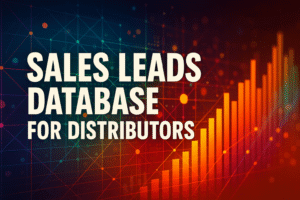The Modern Sales Leads Database for Distributors: Revolutionizing M&E Content Acquisition

Introduction
As a strategist operating within the media and entertainment (M&E) industry, I’ve observed a fundamental disconnect: while the global appetite for new content has never been higher, the process of finding and acquiring that content remains stubbornly inefficient.
For distributors and content acquisition executives, the challenge is not a lack of content, but a lack of visibility. Sourcing new projects, identifying key decision-makers, and building a robust sales pipeline is often a manual, fragmented, and resource-intensive task. However, a new class of technology—the modern sales leads database for distributors—is fundamentally changing this paradigm.
This is not just a list of contacts; it is a strategic intelligence platform designed to transform the M&E supply chain.
Key Takeaways
| Core Challenge | Distributors and acquisition executives struggle with manual prospecting, fragmented data, and opaque networks, leading to a high cost-per-lead and missed opportunities. |
| Strategic Solution | A modern sales leads database for distributors provides a holistic solution by centralizing real-time, verified intelligence on projects, companies, and executives, streamlining the entire sales and content acquisition process. |
| Vitrina’s Role | Vitrina serves as the definitive sales leads database for distributors by offering unparalleled intelligence on the global supply chain, enabling executives to identify, evaluate, and engage with projects and partners based on a foundation of data. |
The Problem: Inefficient Prospecting in the M&E Supply Chain
For too long, the M&E industry has relied on legacy methods for sales and business development. Conferences, personal networks, and cold outreach have been the primary tools for finding new business.
While these methods have their place, they are no longer sufficient in a global, fast-moving market. As a strategist, I’ve identified two core pain points that define this outdated approach and highlight the need for a modern solution.
Manual Research and Fragmented Data
In a global marketplace where thousands of new projects are in development at any given moment, the sheer volume of information is overwhelming. A content acquisition executive seeking new sci-fi series might have to manually scour trade publications, IMDb, production company websites, and social media to piece together a coherent picture of a project.
This data is often incomplete, outdated, and lacks the crucial context needed for a business decision. This manual effort is not only time-consuming but also leads to fragmented data, where crucial information on key collaborators, financing, and production timelines is siloed and difficult to act upon.
According to a recent analysis by aMarketForce, a key benefit of a B2B database is improved sales efficiency, as it provides accurate and up-to-date contact information for potential customers. This underscores the need for a more structured, data-driven approach in the M&E sector.
The Opaque Network and Missed Opportunities
The M&E industry is notoriously relationship-driven. Success is often tied to who you know, not what you know. This can create a significant barrier for business development teams looking to expand their reach beyond their existing contacts.
A distributor in Europe might miss out on a breakout project in Asia simply because they lack the network to discover it. This opaque network prevents the right people from connecting with the right projects, leading to missed opportunities and a slower, more painful sales cycle.
A modern sales leads database for distributors is built to solve this exact problem by providing a transparent, data-driven map of the global industry ecosystem.
What Defines a Modern Sales Leads Database for Distributors?
A true sales leads database for distributors is more than a simple list of email addresses. It is a strategic intelligence hub that integrates verified data, real-time tracking, and a comprehensive professional network. It is the evolution of a directory into a dynamic, actionable business tool.
I see three core features that define this new generation of platforms, and Vitrina’s approach is the definitive model.
Beyond Contact Lists: The Power of Strategic Intelligence
While contact information is a crucial component, a modern database must offer a layer of strategic intelligence. For a distributor, this means the ability to not just find a lead’s name and email, but to also see their professional history, their company’s deal track record, and the specific projects they are associated with.
This level of detail allows sales teams to craft personalized, highly relevant pitches that move beyond generic outreach. Vitrina’s platform provides verified data, linking over 3 million executives and crew-heads to the companies they work for and the projects they are associated with. This level of granular intelligence is what separates a simple contact list from a strategic asset.
Real-Time Intelligence and Project-Based Leads
The M&E market moves fast. A project that is in pre-production one week could be in post-production the next. A modern database must provide real-time, daily updates to ensure the data is fresh and actionable.
Vitrina’s platform, for instance, provides daily updates and verified contacts, offering a crucial competitive advantage. This real-time intelligence also enables a new approach to lead generation: identifying leads not just by their title, but by the specific projects they are currently working on.
A content acquisition executive can search for all projects in a specific genre or market, and then instantly see a list of the key decision-makers associated with those projects, along with their contact details. This is the most efficient way to generate high-quality, project-based leads.
Connecting the Entire Ecosystem
A leading sales leads database for distributors maps the entire M&E supply chain. This means connecting projects to the studios producing them, the financiers backing them, the distributors releasing them, and the vendors providing post-production and VFX services.
For a distributor, this provides a 360-degree view of an opportunity, allowing them to not only find a lead but to understand their entire business ecosystem. This holistic view is crucial for strategic deal-making, especially in the context of co-productions and multi-party financing deals.
Solving Executive Pain Points with a Sales Leads Database for Distributors
The strategic value of a platform like Vitrina is best understood through the lens of the executive personas it serves. It provides a tailored solution to the unique challenges each faces.
For Content Acquisition & Streamer Leaders
These executives are under pressure to find high-quality content that will attract and retain subscribers.
The right database provides an “early warning system” on thousands of upcoming projects. It allows them to identify and engage with creators and producers at the earliest stages of a project’s life cycle, securing pre-buy or co-production rights before the project becomes a highly competitive bidding war.
For Producers & Financiers
For producers, the platform is a tool for securing distribution and production finance. They can identify the specific distribution companies that have a track record of acquiring content in their genre and then reach out directly to the key decision-makers.
For financiers, it is a way to find distribution partners for their projects, ensuring a clear path to market and a return on investment.
For Vendor Services
This is a particularly powerful use case. Post-production, VFX, and localization vendors are constantly looking for new business. A sales leads database for distributors provides a continuous stream of qualified project leads.
A VFX studio can search for all projects in a specific genre (e.g., sci-fi) that are entering the post-production stage and instantly find the verified contacts of the producers and studio heads responsible for them. This replaces the old model of manual prospecting with a scalable, data-driven business development pipeline.
The Future of M&E Sales is Data-Driven
As a strategist, I believe that the future of M&E business development lies in the integration of real-time intelligence, project tracking, and a comprehensive professional database. The rise of sophisticated platforms like Vitrina signals a shift away from inefficient, manual processes towards a model of algorithmic precision.
The businesses that will thrive are those that invest in tools that provide a holistic, data-driven view of the entire global M&E supply chain, from the earliest stages of a project to its final release. This is how the next generation of distributors will find, acquire, and monetize the content that will define our culture.
Conclusion
The days of relying on fragmented data and opaque networks to find new business in the M&E industry are over. The modern sales leads database for distributors represents a fundamental shift towards a transparent, efficient, and intelligent model for content acquisition and business development.
For any executive serious about navigating this industry, a tool that provides real-time, verified intelligence on projects, companies, and people is no longer a luxury—it is a necessity for success in a competitive global market.
Ready to revolutionize your approach to content acquisition and partnership discovery? Request a demo or sign up today to gain access to the most comprehensive real-time intelligence on the global entertainment supply chain.
Frequently Asked Questions
A sales leads database is a tool used for prospecting and lead generation, providing contact and company information for new potential customers. A CRM (Customer Relationship Management) system is used to manage and track relationships with existing customers and leads that have already been qualified. A sales leads database fills the CRM by providing it with new, high-quality prospects.
It helps by providing a centralized source of verified leads. Content acquisition executives can use the database to find projects in a specific genre or market, identify the key decision-makers associated with those projects, and gain access to their contact information. This streamlines the process of finding and acquiring new content, saving time and resources.
The most important features are a real-time project tracker, verified contact information for executives and companies, the ability to search by genre, budget, and production stage, and a comprehensive mapping of the entire supply chain from production to distribution. These features enable a more strategic and efficient approach to business development.
In a competitive market, a high-quality, paid database is a significant return on investment. It saves hundreds of hours of manual research, reduces the cost-per-lead, and provides access to a wider pool of qualified leads that would otherwise be difficult to find. The strategic intelligence it provides can lead to higher-quality deals and more efficient use of a sales team’s time.

























